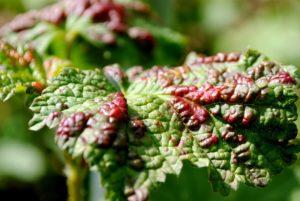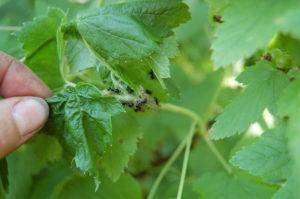Aphids on currants: how to treat bushes from pests
Aphids are definitely one of the most common pest species and the most dangerous. She eats with great appetite and breeds quickly. She does not disdain different types of vegetables, fruit trees and shrubs. Aphids often settle on currants.
Content
Signs of aphids
aphid active in the warm season and since May eats a lot. Wingless individuals emerge from eggs in spring and actively feed on young leaves and buds. Depending on the type of currant, a different type of insect can settle on the bushes.
Common symptoms of aphids are as follows:
- wilting and twisting of foliage;
- slow development of buds and flowers;
- infection of neighboring plants;
- the appearance of ants on the bush.
How to deal with aphids on currants
There are several different ways to deal with aphids. Their choice depends on how large the scale of the infection.
There are many different options here - if you spray with chemicals in the spring, you will not have to monitor the condition of the garden during the season. But if mass infection does not usually occur, then gardeners prefer not to use chemistry.
Chemicals
Insecticides are used most often with severe infection. They should only be used as directed and in protective gear, at least a mask and gloves. They are strictly forbidden to apply less than 30 days before harvest.
Use such drugs:
- Aktellik;
- Aktara;
- Aliot;
- Biotlin;
- Tanrek;
- Spark;
- Intavir;
- Kinmix;
- Fufanon.
If you spray in the spring, but during the season there will be much less pests. However, you need to monitor neighboring plants so that chemicals do not accumulate in them.
Preparations of biological origin
Biological products are special products based on bacterial strains. They act directly on the pest and are safe for humans. Their important feature is that they do not accumulate and do not harm. After processing, berries can be eaten after 2-3 days.
These include:
- Actoverin;
- Fitoverm;
- Bitoxibacillin;
- Akarin.
These substances can also protect against whiteflies, weevils and Colorado potato beetles.
Folk methods of struggle
These are methods based on available materials of plant origin. They are not expensive, but will last a little longer than the previous ones. But all the above drugs do not accumulate in plant tissues and do not harm the fruits.
| Ammonia | For spraying, you will need 2 tbsp. spoons for 10 liters of heated water and a little soap. |
| Soda | For a bucket of water you need 10 tbsp. tablespoons of dry powder and grated laundry soap. |
| Herbal ingredients | It can be infusions of tops, onions, garlic, tobacco, marigolds, dandelions, pine needles. |
| Other liquids | Some unusual means will help - cola, milk, cream, vodka, essential oils. |
Passive protection
This can include methods that do not require the constant participation of gardeners and act on their own.
The Right Neighbors can repel pests. These are many strong-smelling plants: marigolds, dill, basil, calendula, thyme, tansy, wormwood.
Aphids have natural enemies, the involvement of which will help reduce the invasion. These are ladybugs, lacewings and ground beetles. They are attracted to fragrant flowers like daisies, alyssums or marigolds. You can buy ladybugs in special stores.
Small aphids are good prey for birds that carry food to their chicks. These are sparrows, tits, willows, robins, warblers, wrens. They are attracted to feeders and birdhouses.
You can make work easier if you get acquainted with the advice of an experienced gardener. More about them article 26 ways to protect against aphids.
Preventive measures
Any problem is better to prevent than to heal. Prevention of the appearance of aphids on currants is very simple:
- Carry out thinning and spraying.
- Remove weeds and debris.
- Expel ants in a timely manner.
- Monitor the plant for the first signs of infection.
- When aphids appear on any plant, immediately inspect the entire garden.
Conclusion
Aphids on currants appear quickly and multiply actively. It can cause great harm and even deprive the crop. The fight against it is carried out at the first symptoms, and prevention - all year round.

